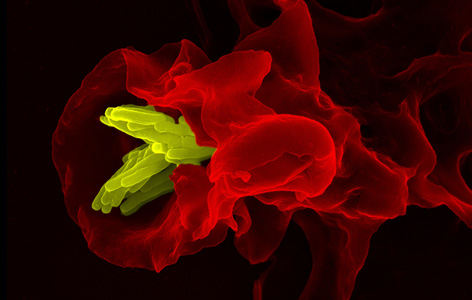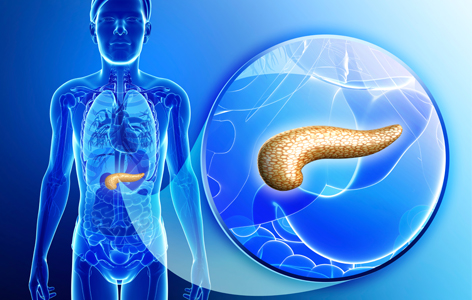 As UHN's monthly research newsletter, NRx reports on the full spectrum of research from UHN's five research institutes: the Princess Margaret (PM) Cancer Centre, the Toronto General Research Institute (TGRI), the Krembil Research Institute (Krembil), the Toronto Rehabilitation Institute (TRI) and the Techna Institute (Techna).
As UHN's monthly research newsletter, NRx reports on the full spectrum of research from UHN's five research institutes: the Princess Margaret (PM) Cancer Centre, the Toronto General Research Institute (TGRI), the Krembil Research Institute (Krembil), the Toronto Rehabilitation Institute (TRI) and the Techna Institute (Techna).
In this issue you can read about:
- How more women could benefit from cardiac rehab
- A key factor that influences spinal cord surgery success
- Why brain cancer develops differently in children and adults
- How arterial macrophages develop
- A new experimental model of pancreatic cancer
- The UHN 2015 Research Report: E = Health
Christopher J. Paige, PhD, FCAHS
Executive Vice President, Science and Research
University Health Network
When provided access, women attend less than half of their prescribed cardiac rehab sessions

Those who participate in a cardiac rehabilitation program could potentially reduce their risk of dying from heart disease by more than 26%.
Cardiac rehabilitation programs are vital to recovery after a heart attack. They incorporate education, exercise and counselling to help those recovering from heart problems to understand their condition, improve their physical fitness and manage their disease.
Toronto Rehab Senior Scientist Dr. Sherry Grace explains, “Participating in a cardiac rehab program not only greatly reduces death and hospitalization but also helps improve quality of life. Unfortunately, many patients do not use these proven services, and women are much less likely than men to access and fully participate in these programs.”
To determine what factors might improve the participation of female patients in cardiac rehab programs, Dr. Grace and her colleagues analysed who participated in rehabilitation programs across six cardiac rehabilitation facilities in Ontario that offer mixed gender, women’s only or home-based programs.
After assessing the level of adherence to each program, the team discovered that participants attended less than half of the rehabilitation sessions prescribed to them, regardless of the type of program they attended. Women also appeared to have strong preferences for which model they preferred to attend.
“The results suggest that women should be encouraged to participate in cardiac rehab, offering them the program model of their choice,” says Dr. Liz Midence, lead author of the article. “We should inform women of the benefits of cardiac rehab and use all the tools at our disposal to promote their full participation”
This work was supported by the Heart and Stroke Foundation of Ontario Grant-in-Aid #NA 6682.
Cardiac rehabilitation program adherence and functional capacity among women: a randomized controlled trial. Grace SL, Midence L, Oh P, Brister S, Chessex C, Stewart DE, Arthur HM. Mayo Clinic Proceedings. 2015 Dec 9. doi: 10.1016/j.mayocp.2015.10.021. [Pubmed abstract]
Researchers identify a key factor that influences spinal cord surgery success

Patients with cervical spondolytic myelopathy can experience a wide range of symptoms from mild neck pain and numbness in the hands to difficulty standing.
Cervical spondolytic myelopathy (CSM) is the leading cause of spinal cord injury in individuals over the age of 55. It occurs when the spinal cord becomes compressed due to chronic and progressive deterioration of the spine.
Surgery can alleviate some of the symptoms associated with CSM and improve the quality of life for patients with the disease. However, many patients continue to have residual neurological dysfunction despite surgery and operative intervention has a low but definite risk of neurological complications.
By using an experimental model of CSM, Krembil Senior Scientist Dr. Michael Fehlings and his team have been able to determine why decompression surgeries can sometimes lead to neurological decline.
They found that CSM post-surgery complications are partly caused by a rapid increase in blood flow, which occurs when the pressure on the spinal cord is removed. Administering riluzole—a drug that has been shown to protect the health of neurons—can protect the spine from injury after the surgery and reduce the risk of any additional neurological decline.
“Our report identifies a silent, and thus far unrecognized factor that may account for the rate of post-surgical complications in patients with CSM,” explains Dr. Fehlings. “Based on these findings, we have launched a large-scale North American clinical trial to determine whether riluzole can improve outcomes for patients with CSM following decompression surgery.”
This work was supported by the Cervical Spine Research Society, the Canadian Institutes of Health Research, the Gerry and Tootsie Halbert Regeneration Chair, AOSpine North America and the Toronto General & Western Hospital Foundation.
Riluzole blocks perioperative ischemia-reperfusion injury and enhances postdecompression outcomes in cervical spondylotic myelopathy. Karadimas SK, Laliberte AM, Tetreault L, Chung YS, Arnold P, Foltz WD, Fehlings MG. Science Translational Medicine. 2015 Dec 2;7(316):316ra194. doi: 10.1126/scitranslmed.aac6524. [Pubmed abstract]
Study uncovers why one type of brain cancer develops differently in children versus adults

Glioblastomas, which account for approximately 43 percent of all brain cancers, always recur after initial treatment.
Glioblastoma is a particularly aggressive brain cancer that is highly resistant to treatment in part because a small subset of glioblastoma cells acquire the ability to self-renew. This small population of cells often evade treatment, which is why researchers are seeking new methods to target them.
A recent study led by PM Cancer Centre Dr. Mathieu Lupien and his SickKids collaborator Dr. Peter Dirks has revealed that adult glioblastoma cells may acquire these self-renewing properties due to the decreased expression of a protein known as H3.3.
H3.3 plays an important role in the way DNA is packaged by providing a scaffold onto which the DNA can be tightly wrapped. Defects in the H3.3 gene have been linked to the development of childhood glioblastomas; yet adults who develop the disease seldom have a dysfunctional H3.3 gene.
The team led by Drs. Lupien and Dirks discovered that self-renewing glioblastoma cells from adult patients express a protein known as MLL5, which represses the expression of H3.3. A reduction in levels of H3.3 caused by MLL5 expression leads to reorganization of specific regions of the chromosome, which makes the DNA more compact. This compacted DNA structure favors expression of the genes that glioblastoma cells need to self-renew.
The team has since identified two chemical compounds that may prevent adult glioblastoma cells from acquiring this ability to self-renew. Further development of these compounds may lead to new drugs, providing an alternative treatment for patients with glioblastoma, who generally have poor prognoses and limited treatment options.
This work was supported by Genome Canada, the Ontario Institute for Cancer Research, the Hospital for Sick Children Foundation, Jessica's Footprint, Hopeful Minds Foundation, BrainChild, the Canadian Cancer Society Research Institute, the Canadian Institutes of Health Research and The Princess Margaret Cancer Foundation. J Dick holds a Tier 1 Canada Research Chair in Stem Cell Biology.
MLL5 orchestrates a cancer self-renewal state by repressing the histone variant H3.3 and globally reorganizing chromatin. Gallo M, Coutinho FJ, Vanner RJ, Gayden T, Mack SC, Murison A, Remke M, Li R, Takayama N, Desai K, Lee L, Lan X, Park NI, Barsyte-Lovejoy D, Smil D, Sturm D, Kushida MM, Head R, Cusimano MD, Bernstein M, Clarke ID, Dick JE, Pfister SM, Rich JN, Arrowsmith CH, Taylor MD, Jabado N, Bazett-Jones DP, Lupien M, Dirks PB. Cancer Cell. 2015 Dec 14. doi: 10.1016/j.ccell.2015.10.005. [Pubmed abstract]
Findings reveal that the origins of certain type of macrophage vary as we grow older

Macrophages (in red) act like scavengers, engulfing not only dead debris but also invading bacteria (yellow).
Our bodies are populated with specialized immune cells called macrophages, which maintain the health of our tissues and arteries. Although much is known about the role that they play as part of the immune system, it is not clear in certain cases where macrophages originate.
A recent study by TGRI Senior Scientist Dr. Clinton Robbins and his collaborators has provided new insight on this subject by uncovering key mechanisms that sustain the macrophages that reside in our arteries (known as arterial macrophages).
The team made the discovery by analyzing the genetic profiles of macrophages at different stages of human development. They found that arterial macrophages, which represent a distinct macrophage population, have varying origins as we grow older.
In the embryo, arterial macrophages develop from a macrophage precursor cell that expresses a specific protein on its cell surface, known as CX3CR1. Immediately after birth, arterial macrophages originate from a different type of cell, known as a monocyte.
However, in adulthood, arterial macrophages gain the ability to divide and regenerate into cells with similar properties. This enables them to increase in number in the absence of precursor cells or monocytes.
Explains Dr. Robbins, “Our findings underscore the need for more careful examination of the factors that maintain macrophage populations in tissues. Insights from these studies could provide new strategies for treating diseases such as atherosclerosis, where abnormal accumulation of macrophages on the artery walls leads to the formation of lesions that interfere with blood flow.”
This work was supported by the Canadian Institutes of Health Research, the Ontario Lung Association Pfizer Award, the Peter Munk Chair in Aortic Disease Research and the Toronto General & Western Hospital Foundation.
Self-renewing resident arterial macrophages arise from embryonic CX3CR1(+) precursors and circulating monocytes immediately after birth. Ensan S, Li A, Besla R, Degousee N, Cosme J, Roufaiel M, Shikatani EA, El-Maklizi M, Williams JW, Robins L, Li C, Lewis B, Yun TJ, Lee JS, Wieghofer P, Khattar R, Farrokhi K, Byrne J, Ouzounian M, Zavitz CC, Levy GA, Bauer CM, Libby P, Husain M, Swirski FK, Cheong C, Prinz M, Hilgendorf I, Randolph GJ, Epelman S, Gramolini AO, Cybulsky MI, Rubin BB, Robbins CS. Nature Immunology. 2015 Dec 7. doi: 10.1038/ni.3343. [Pubmed abstract]. Image courtesy of Dr. Volker Brinkmann, Max Planck Institute for Infection Biology and is licensed under CC BY-NC-ND 2.0.
3D clusters of tumour cells re-create important features of patient disease

The pancreas is an organ located behind the stomach, which secretes enzymes that aid digestion and hormones that modulate blood sugar levels.
Pancreatic cancer is the deadliest form of cancer affecting Canadians: according to the Canadian Cancer Society, 93% of patients succumb to the disease within five years of their diagnosis. In light of these dismal statistics, researchers are working tirelessly to develop more effective treatments for the disease.
PM Senior Scientist Dr. Sentil Muthuswamy and his collaborators have developed a new experimental model of pancreatic cancer that could provide patients with more personalized treatments and improved health outcomes.
The new model consists of three-dimensional clusters of cells derived from patient tumour samples, which can be cultured and grown in the laboratory. The researchers found that these clusters preserve many of the physiological features of the original tumour, recapitulating aspects of a patient's disease more accurately than other models currently available. In particular the researchers found that clusters originating from different tumours displayed differential sensitivity to an anti-cancer drug.
These findings suggest that tumour cell clusters could be used for personalized drug screens to identify the most effective treatment regimen for each patient's pancreatic cancer. However, larger and more rigorous studies are needed before this strategy can be incorporated into clinical practice.
This work was supported by the Ontario Institute for Cancer Research, the Canadian Cancer Society, the Campbell Family Institute for Breast Cancer Research, the Ontario Ministry of Health and Long-Term Care and The Princess Margaret Cancer Foundation. C Arrowsmith and G Keller hold Tier 1 Canada Research Chairs in Structural Proteomics and in Embryonic Stem Cell Biology, respectively.
Ductal pancreatic cancer modeling and drug screening using human pluripotent stem cell- and patient-derived tumor organoids. Huang L, Holtzinger A, Jagan I, BeGora M, Lohse I, Ngai N, Nostro C, Wang R, Muthuswamy LB, Crawford HC, Arrowsmith C, Kalloger SE, Renouf DJ, Connor AA, Cleary S, Schaeffer DF, Roehrl M, Tsao MS, Gallinger S, Keller G, Muthuswamy SK. Nature Medicine. 2015 November. [Pubmed abstract]
Learn how energy drives research at UHN and inspires innovations that improve health care

Click here to read the latest Research Report.
Through exciting stories and features, this report illustrates the diverse ways in which UHN researchers are working to improve health and health care, for example: by providing new insights into how exercise impacts health; building powerful computational tools for biomedical research; and finding new ways to repair pathways that are disrupted in diseases such as diabetes.
It also demonstrates—through funding successes, innovative research applications and support from UHN foundations—that, ultimately, the energy from thousands of individuals who work at UHN is the key to our success.
 Dr. Shepherd (pictured top) received her appointment for her contributions towards improving treatment options and outcomes for individuals with advanced lung cancer.
Dr. Shepherd (pictured top) received her appointment for her contributions towards improving treatment options and outcomes for individuals with advanced lung cancer. 
 PM Senior Scientist Dr.
PM Senior Scientist Dr. 
 By using a new cell sorting method, PM Senior Scientist Dr. John Dick was able to provide a revised model for blood production that challenges current views on how blood is produced. The findings, published in
By using a new cell sorting method, PM Senior Scientist Dr. John Dick was able to provide a revised model for blood production that challenges current views on how blood is produced. The findings, published in 
 Every December, the editors of Nature Medicine—a prestigious and widely read journal—publish a list of the most notable achievements in biomedical research. This year, two studies were featured that were published by UHN researchers Dr.
Every December, the editors of Nature Medicine—a prestigious and widely read journal—publish a list of the most notable achievements in biomedical research. This year, two studies were featured that were published by UHN researchers Dr.